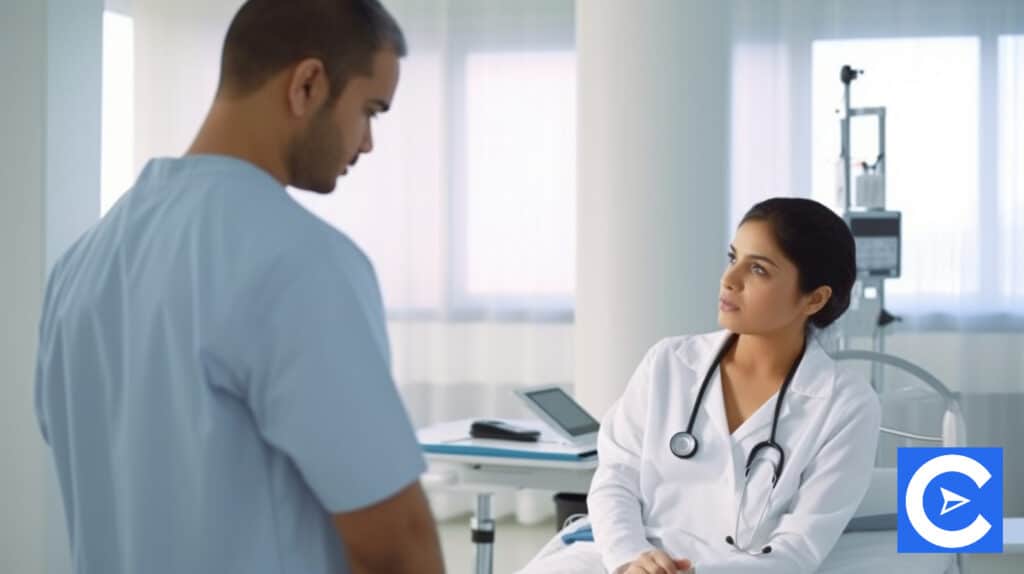Other Free NCLEX RN Study Guides:
There are 8 Modules in NCLEX RN Study Guide. Here you can navigate all the NCLEX RN Study guide modules.
- NCLEX Study Guide Home
- Module 1 | Managing Care Of the Patient
- Module 2 | Overall Safety and Control of Infections
- Module 3 | The promotion of health and maintenance
- Module 4 | Integrity in psychosocial functioning
- Module 5 | Providing Basic Care and Ensuring Patient Comfort
- Module 6 | Therapies: Pharmacological and parenteral
- Module 7 | Potential risk reduction
- Module 8.1 | Adapting physiologically
- Module 8.2 | Adapting physiologically
- Module 8.3 | Adapting physiologically
let’s get started right
Otitis externa, Temporal arteritis and recurrent epistaxis

Recurrent epistaxis
It’s in young children between the ages of 2 and 10 years old that this is found, particularly in boys.
There are several factors related to recurrent epistaxis including dry climates, cold winters where central heating is used, and nose-picking.
Between the ages of 50 and 80, incidents will increase as well and are often caused by anticoagulants and NSAIDs.
It must be noted that major blood loss is possible if bleeding takes place in the posterior nares.
Treatment includes:
- Placing the patient in an upright position. They should be leaning forward. This stops blood flowing down their throats
- Pressure should be applied below the nares. Alternatively, the nostrils can be pinched. This should be down firmly and for around 10 mins
- The use of topical vasoconstrictors and/or packing may be necessary in cases of severe bleeding
- Irritation can be decreased by using humidifiers
Temporal arteritis (TA)
This is when blood vessels in the head suffer inflammation.
It usually affects two in particular: the thoracic aorta and branches as well as the temporal artery.
In around 30% of patients or less, TA is associated with polymyalgia rheumatica.
It can be associated with lupus erythematous, Sjogren syndrome, and rheumatoid arthritis as well.
This progressive disorder is common in people of 50 and older and can end in blindness.
Symptoms include:
- Headaches
- Fluctuations in vision, loss of vision
- Pain in the upper extremities, tongue, and jaw intermittently
- Fever
For a definitive diagnosis, a temporal artery biopsy can be carried out, while to prevent blindness, the patient should be treated with Prednisone.
Otitis externa
This refers to infected ear canals.
This infection can either be mycotic or bacterial.
Often, swimmers can suffer from this as bacteria can multiply due to pool chlorine killing the normal flora found in the ear canals.
Immune disorders, diabetes, and steroids can all increase the risk of the fungal infections variety of this disorder.
Symptoms include:
- Exudate, swelling, and pain
- Itching (most notable in fungal infections)
- Pustular lesions that are red in color
- Tympanic membrane covered in fungus that shows as black spots
Treatment consists of:
- Using saline or Burow’s solution irrigate and clean out the ear
- If bacteria are present, ear drops can be used
- If a fungus is present, a solution of 5% boric acid in ethanol can be used or a clotrimazole-miconazole solution too
- As needed, analgesics can be administered
TMD, sinusitis and Otitis media

Otitis media
This refers to inflammation of the middle ear and in many cases, it comes about through allergic rhinitis or after an upper respiratory tract infection.
The infection is caused by fluid pooling in the mucous membrane as a result of the swelling of the eustachian tube.
Usually, this takes on one of four forms:
- Acute: 1-3 week period
- Recurrent: Around 3 examples in six months or 4 to 6 in a period of a year
- Bullous: This is an acute infection leading to pressure in the middle ear, hearing loss, and pain
- Chronic: Constant for a period of three months with drainage and hearing loss as well as thick retracted tympanic membrane
Signs of inflammation, the presence of purulent fluid, and a perforated or bulging tympanic membrane are signs of this.
Treatment includes antibiotics for the most part, in recurrent or chronic infections, a referral for tympanostomy and pressure-equalizing tubes can be given.
Sinusitis
This is when the nasal sinuses become inflamed which can result in discomfort as drainage is obstructed.
Symptoms are as follows:
- Pain over the sinuses
- Dull aches behind the eye and ethmoidal are present
- Tenderness of the sinuses
- Purulent exudate
- Nasal cavity mucosa
Treatment options are:
- Analgesia for symptomatic relief
- Nasal irrigation and topical decongestants
- If problems persist for a long period (more than 7 days), antimicrobial therapy may be necessary
- The use of steroid nasal sprays
Temporomandibular disorder (TMD)
Dysfunction of the temporomandibular joint as the muscles and ligaments that support it can cause jaw pain known as TMD.
This can be a result of injuries the patient has received, for example, whiplash.
It may also be a result of them clenching or grinding their teeth, while TMD could result in arthritis sufferers as well as from stress.
Symptoms of TMD are:
- Jaw movements leading to popping and clicking sounds
- Locked jaw or limited movement of the jaw
- Pain when moving the jaw and chewing
- Dizziness
- Headaches
- Toothache
When it comes to diagnosis, a CT or MRI scan may be necessary while disorders can be ruled out with a dental exam and x-rays.
Treatment includes:
- Ice packs and jaw stretching exercises
- Avoiding hard foods that will lead to heavy chewing
- Pain and inflammation relieved through NSAIDs
- Mouthguards when sleeping
- Dental treatment to improve bite, if necessary
Shock and infection

Severe infection ranges
Several terms are used to refer to severe infections including:
- Bacteremia is when there isn’t a systemic infection but bacteria are present in the blood
- Septicemia refers to pathogens (either fungi or bacteria) in the blood that causes a systemic infection
- Systemic inflammatory response syndrome (SIRS) affects many organ systems and is a generalized inflammatory response
- Sepsis is a local or systemic infection with generalized SIRS
- Severe sepsis includes both indications of sepsis and SIRS
- Septic shock is the next step from severe sepsis and here, despite treatment, refractory hypotension occurs
- Multi-organ dysfunction syndrome (MODS): In sepsis deaths, this is the most common cause. Here, patients can develop ARDs while cardiac function becomes depressed with renal failure following acute tubular necrosis or cortical necrosis. Bowel and liver necrosis may also occur
Shock
Shock comes in many forms but all have fairly general characteristics.
- Hypotension with a systolic blood pressure reading of 90mmHG or below
- Urinary output decreases
- Metabolic acidosis
- Cool, clammy skin as a result of peripheral/cutaneous vasoconstriction/vasodilation
- Varying levels of consciousness
The following are different types of shock that you should know:
- Distributive
- Cardiogenic
- Hypovolemic
Your coursework goes into excellent detail regarding septic, distributive, neurogenic, and anaphylactic shock as well.
Toxic exposures and malignant hyperthermia

Malignant hyperthermia
This life-threatening condition comes about due to genetic susceptibility to anesthetics that are inhaled.
Patients can show signs of this fairly quickly, within a period of 10-20 minutes or it may manifest over time (more than 24 hours).
Effects include the following:
- Cytoplasmic calcium increases. This causes muscles to contract
- Increasing temperature and hypermetabolism
- Cell leakage
Systemic manifestations can include:
- Ventricular cardiac dysrhythmias
- Hemorrhage
- Increased ICP
- Kidney failure
- Cardiac arrest
Exposure to toxic materials
Carbon Monoxide poisoning
A person can suffer carbon monoxide (CO) poisoning from many different sources.
For example, they could inhale smoke, gas or coal heater emissions, engine produced fossil fuel emissions, and more.
When this happens, oxygen delivery is severely impaired because the CO will bind to the hemoglobin in the blood.
This prevents oxygen from being carried effectively by the blood.
Symptoms include:
- Cardiac: Chest pain, decreased capillary refill, hypotension, palpitations, and cardiac arrest
- CNS: Seizure, coma, stroke, vomiting, nausea, and lethargy
- Secondary injuries can include encephalopathy, failure of multiple organs, non-cardiogenic pulmonary edema, AKI, and rhabdomyolysis
Treatment options include:
- Support immediately provided for circulation, breathing, and airway
- 100% non-barometric oxygen
- If a mild case, oxygen can be continued for 4 hours with the patient constantly reassessed
- If severe, oxygen delivery can be improved using hyperbaric oxygen therapy
Cyanide poisoning
This can result from many sources, including inhalation of fumes from burning plastics, sodium nitroprusside infusions, dermal exposure, or accidental or intentional ingestion, amongst others.
Symptoms depend on overall severity and can change due to the amount of exposure.
They include:
- Tachycardia
- Bradycardia
- Hypertension
- Hypotension
- Cardiac arrest
- Cherry or pink-colored skin
- Headache
- Dyspnea
- Tachypnea
- Respiratory arrest
- Lethargy
- Seizures
Treatment should include:
- Supportive care
- If clothes are contaminated, they must be removed
- Gastric decontamination
- Irrigation for tropical exposure
- Administering antidotes (amyl nitrate, sodium nitrite, sodium thiosulfate)
Allergic reactions
These can come about for a variety of reasons including medications, illegal substances, and exposure to toxins.
In certain cases, they can be life threatening but it depends on the degree of exposure and what the patient was exposed to that determines their physiologic response.
As a result of exposure, lactic acidosis and tissue hypoperfusion often result which can lead to organ failure, metabolic acidosis, shock, and even death.
The symptoms of an allergic reaction can include:
- Back pain
- Chest pain
- Abdominal pain
- Pruritus
- Urticaria
- Flushing in the face
- Wheezing
- Shortness of breath
- Nausea
- Diarrhea
- Vomiting
Treatment begins first with eliminating exposure to the allergen, toxin, or drug.
If antidotes are available, they should be administered immediately, while if the patient has a medication or drug overdose, they can be given activated charcoal.
If suffering an allergic reaction, the patient should be given corticosteroids and antihistamines while epinephrine can be used to treat severe cases.
Ethanol overdose
It’s the central nervous system of a patient that will be affected by an ethanol overdose.
It will affect other organs too, however.
100 mg/dL is the blood alcohol level that’s associated with intoxication, while around 500 mg/dL or higher sees a high mortality rate.
It’s through the mucosa of the mouth, stomach, and intestines that ethanol is absorbed.
Symptoms include the following:
- An altered state of mind
- Vomiting
- Nausea
- Hypotension
- Bradycardia with arrhythmias
- Hypoxia and respiratory depressing
- Cold, clammy skin or flushed skin
- Abdominal pain from acute pancreatitis
- Consciousness problems
- Circulatory collapse
Treatment includes:
- Arterial blood gasses and oxygen saturation should be closely monitored
- Patient airways should be secured
- Intravenous fluids should be administered
- If hypoglycemia is indicated, dextrose can be given
- Body temperature should be maintained
- In severe cases, dialysis may be necessary
Hypothermia, heat-related illness, and burns

Hypothermia
This can occur when the core temperature of the human body falls below 95 degrees Fahrenheit.
This can result from exposure to cold temperatures, and immersion in cold water, but also due to metabolic disorders and abnormalities in the CNS.
The symptoms of hypothermia include the following:
- Cold skin
- Drowsiness
- Pallor
- Changes in mental status
- Severe shivering
- Confusion
Patients with hypothermia can move into shock, a coma, dysrhythmias, and cardiac arrest.
Treatment includes:
- Passive rewarming of the patient but only if they have a stable cardiac status
- External active rewarming using a heating blanket or immersion in warm water
- Internal active rewarming using warm humidified oxygen, IV fluids that are heated, and internal lavage
- Extracorporeal circuit warming
- Further supportive treatment
Heat-related illness
It’s particularly children and the elderly that are susceptible to heat-related illnesses.
These types of illnesses include:
- Heat stress: This causes dehydration with patients developing a number of symptoms including sunburn, itchy skin, hands and feet that swell, heat syncope, and cramps. Patients should be taken out of the heat, cool, hydrated, and take in sodium replacements
- Heat exhaustion: This occurs when someone is depleted of water and sodium. Symptoms include an aching body, vomiting, nausea, headaches, dizziness, diaphoresis, and a clammy skin. Patients should take in sodium and fluids to replace that which has been lost and they should be cooled off as well so as to prevent heat stroke
- Heat stroke: Heat stroke sees the thermoregulatory system shut down. Patients experiencing heat stroke can experience varying symptoms, many of which are extremely serious. These include neurological damage, seizures, failure of multiple organs, and even death. Treatment for heat stroke patients should include rehydration, evaporative cooling, and other supportive treatment for organs, if necessary
Burns
Burn types and classifications
When assessing burns, the area, percentage of the body burned and their overall depth is used to classify them.
- First-degree burns: This affects the epidermis but is superficial. Patients will experience pain and erythema
- Secondary-degree burns: It’s through the dermis that these burns will extend. There is also sloughing of the epidermis while blistering occurs as a result
- Third-degree burns: Here, the underlying tissue is affected which includes, nerves, muscles, and vasculature
The American Burns Association criteria for the classification of burns is as follows:
- Minor: 10% or less of the body surface area
- Moderate: 10 to 20% of the body surface area
- Major: 20% or more of the body surface area
Burns can contribute to various systemic complications including:
- Cardiovascular: In some cases, the output of the cardiac system can fall by as much as 50%. This is a result of fluid leaking from tissue and the increase in capillary permeability
- Urinary: Kidneys will increase ADH because of decreased blood flow. This in turn, intensifies oliguria. There is an increase in creatinine and BUN levels, while as a result of hemolysis, hematuria can occur
- Pulmonary: Smoke inhalation can lead to injury to the pulmonary system
- Neurological: Due to a lack of oxygen, lower blood volume, and sepsis, encephalopathy may occur. As a result, a patient may drop into a coma, experience seizures, or hallucinate
- Gastrointestinal: Poor circulation can result in Ileus and ulcerations.
- Endocrine/metabolic: Epinephrine and norepinephrine are released to raise cardiac output as well as cortisol to promote wound healing. This is carried out by the adrenals under stimulation from the sympathetic nervous system. A patient’s metabolic rate will also rise and because of exposed tissue and fluid loss, they will lose electrolytes.
Treatment for burns includes the following:
- Helping to establish an airway for the patient
- Treat them for inhalation injury
- Provide electrolytes and intravenous fluids
- Enteral feedings
- To ensure gastric decompression and to prevent aspiration, an NG tube can be used
- Urinary output can be monitored using an indwelling catheter
- Pain and anxiety can be reduced through analgesia
- Provide systemic and topical antibodies
- Wound care
Your coursework contains specifics regarding chemical, electrical, and thermal burns.
Multisystem procedures, and interventions

Ensuring critically ill patients are thermoregulated
To regulate the core temperature of the body, many parts play a role.
This includes the limbic system, spinal cord, lower brainstem, sympathetic ganglia, and reticular formation.
When patients have spinal or brain trauma, sepsis, have suffered a stroke, or have CNS tumors, impaired thermoregulation can result.
During deep sedation, mild hypothermia is common in patients, and this can lead to infections in wounds, blood loss as well as advertised cardiovascular occurrences.
There are many different classifications of patients where hypothermia can play a role including those with sepsis, patients post-op, those with severe burns, and those who had suffered trauma.
Hyperthermia is associated with heatstroke, neuroleptic malignant syndrome, serotonin syndrome, and systemic inflammatory response syndrome.
Targeted temperature management
This was previously known as therapeutic hypothermia and is used to lower ischemic tissue damage.
This damage is usually associated with neurogenic fever, spinal cord or brain injuries, ischemic stroke, or cardiac arrest.
Through the reduction in body temperature, a neuroprotective effect is achieved.
This means because there is less permeability to cell membranes and in turn, this reduces neurologic edema and damage.
After an ischemic event, hypothermia should be started as soon as possible.
Using cooled saline administered through a femoral catheter is the way to induce hypothermia at around 33 degrees celsius or alternatively, hypothermic water blankets can be used.
If a rapid reduction in temperature is required, both methods can be used.
To reduce the shivering response in patients, they can be given desflurane or meperidine.
There are risks to hypothermia which we covered above, so these should be noted.
When the patient is rewarmed, it’s at 0.5 to 1.0-degree celsius per hour and this can be achieved through a warming blanket, intravenous fluids that are warmed, or warm air.
Continuous temperature monitoring
There are several ways in which this can be carried out:
- Pulmonary artery catheter
- Foley or rectal temperature probe
- Skin probes
- Bluetooth monitors
Continuous temperature monitoring indications include:
- As a way to assess the perfusion of a patient with a skin flap transplantation
- To assess thermoregulation in patients with brain injuries
- For cardiac arrest patients or those who have had post-cardiac surgery while receiving therapeutic hypothermia treatment
- To check for signs of infection in immunocompromised patients
- For patients that are critically ill and at risk of temperature dysregulation
Burn injury fluid resuscitation
As they’ve lost body fluids, burn victims may be at risk from electrolyte imbalances and hypovolemia.
When experiencing burns of 20% or more of their total body surface, fluid resuscitation is necessary using Lactated Ringers IV solution.
The volume needed is calculated using the Parkland/Baxter formula:
- 24 hour volume = (body weight [kg]) x (TBSA burned [%] x (4 mL)
For the first 8 hours, half of the volume should be administered to the patient.
The rest of the volume will follow and is then given in the following 16-hour period.
Around 30-60 mL of urine should be produced per hour once this is carried out.
During the second period of 24 hours, the fluid volume should be between 1.5 and 2 times higher than regular maintenance values with crystalloid and correct electrolyte balance.
Sedation
Minimal sedation
Typically, this includes
- An analgesic medication or sedative dosage that’s not required to be given under medical supervision
- Peripheral nerve block
- Topical/local anesthesia
- Nitric oxide in oxygen (<50% in oxygen)
Patients receiving mild sedatives should be awake, aware, and able to respond to both tactile and verbal stimulation as well as maintain their own airways.
There should be no respiratory or cardiovascular effects from the above medications.
Mild sedation has a number of intended effects, for example:
- It can be used to decrease pain perception in patients
- It can be used to reduce overall fear
- It can be used as a way to relax patients
Obviously, to ensure that a patient isn’t excessively sedated, the process should be monitored, along with their level of consciousness and pain.
This form of sedation is used during minor procedures as well as labor.
Continuous vs intermittent sedation
When patients are critically ill, these are often the sedation choices.
It’s through an IV push that intermittent sedation is administered to the patient.
This means that it has a short expected duration.
This can be used for patients that are on ventilation but most often, it’s used for those that are getting endoscopic procedures.
One of the advantages of using intermittent sedation is that a patient is unlikely to be oversedated.
A steady intravenous infusion is how continuous sedation is administered to patients with agents used including propofol, midazolam, and various opioids.
More often than not, it is patients that are mechanically ventilated that will have this form of sedation administered to them.
At all times for both these types of sedation, the vital signs of the patient, along with their temperature, respiratory status, and oxygen saturation levels, should be monitored.
Neuromuscular blockade agents (NMBAs)
When a patient has not responded adequately to another form of sedation and if it is necessary to induce paralysis, they can be given neuromuscular blocker agents.
This is particularly useful in cases where they need to be mechanically ventilated or when intubation is necessary.
They should only ever be administered after the patient has received adequate sedation because they don’t produce analgesia, amnesia, or unconsciousness.
NMBAs consist of both depolarizing and non-depolarizing agents.
When using them, the eyes of the patient should remain closed while lubricant should be applied in two hourly periods.
Patients should be repositioned often, while it’s never beyond the normal range that any range of motion exercises should extend.
Moderate sedation
Steps included for this, which are used in procedures such as a colonoscopy, for example, follow the ASA sedation guidelines.
They include:
- Pre-procedure evaluation: This entails looking through the health records of a patient, laboratory testing as well as a physical examination. This will occur in the weeks leading up to the procedure. A few days before the patient is due for the procedure, they will be re-evaluated
- Patient preparation: If necessary, a consultation will take place with a specialist. The patient must also provide informed consent and follow all pre-procedure requirements, for example, fasting. An intravenous line will also need to be inserted at this point, if necessary
- Patient monitoring: The following should occur – LOC at five-minute intervals, hemodynamic, and oxygenation/ventilation. Someone should be designated to both monitor and record
- Supplemental oxygen: Unless the condition of the patient contraindicates it
- Emergency interventions: Reversal agents for opioids and benzodiazepines must be readily available while a staff member that is trained to assess the patient and use these agents must be available. Resuscitative equipment must also be present
- Sedatives: As appropriate and this could include various combinations of drugs as well as analgesics
- Sedative and analgesics intended for general anesthesia: Consistent care is necessary as per the use of any general anesthesia and IV medication
- Recovery care: This includes monitoring ventilation, oxygenation as well as circulation. This will be carried out every 5 to 15 minutes
Delayed emergence
When a patient fails to emerge once anesthesia ends, they are said to have delayed emergence.
This usually happens in a time from 30 to 60 minutes after they’ve received the last of the anesthesia.
Because of slowed metabolism caused by anesthetic agents, this most often occurs in the elderly but there could be other causes in any patient.
An example of this would be if during surgery they received a drug overdose as well as pre-induction use of alcohol or drugs which could result in an overdose.
If benzodiazepines or opioids are implicated in the delayed emergence, flumazenil or naloxone may be indicated, while the effects of other anesthetic agents can be reversed using physostigmine.
A delay in emergence could be the result of hypothermia, and in these cases, the temperature of the patient can be increased using forced-air warming blankets.
Emergence could also be affected by both hyper and hypoglycemia.
If they’ve had either cerebrovascular, cardiovascular, or neurological surgery, a patient that enters delayed emergence should be evaluated for a perioperative stroke.
Lastly, emergence can be delayed by metabolic disturbances.
Postanesthetic respiratory complications
Respiratory complications often occur during the postoperative, postanesthesia period.
Patients need to be monitored to prevent hypoxemia, specifically with regard to their oxygen levels.
Monitoring should include the following:
- Airway obstructions: This could be a total obstruction or only partial. Wheezing or sonorous respirations show someone that has a partial obstruction. A total absence of breath sounds will be noted as well. Supplemental oxygen, repositioning, airway insertion, or positive pressure ventilation for laryngospasm is the treatment options when this occurs. Corticosteroids by IV are an option if the obstruction is caused by edema of the glottis
- Hypoventilation: While PaCo2 less than 45 mmHg is fairly mild, respiratory acidosis may result. The cause of this is usually anesthetic-induced depression. Slow emergence could also result from several factors including metabolism, overdose, and hypothermia and this could result in hypoventilation. In some cases, this is a result of splinting due to pain. In this case, pain management is required
- Hypoxemia: This is commonly associated with increased right to left shunting and/or hypoventilation. As for treatment, well giving the patient around 30 to 60% supplementary oxygen is necessary. This can be with or without positive airway pressure.
Postanesthetic cardiovascular complication
If following surgery, a patient experiences cardiovascular complications, they can often be related to respiratory difficulties that they experience.
These complications can include the following:
- Hypotension: This usually is fairly mild, and might not require any form of treatment. The cause is hypovolemia and should the BP of the patient fall between 20 to 30% lower than the baseline, it could cause issues. To confirm hypovolemia, a bolus (IV colloid) is used. In severe cases, patients can be given vasopressors. Careful respiratory assessments should be carried out because it’s in the pneumothorax where hypovolemia can occur
- Hypertension: If this does occur, it’s going to happen 30 minutes after surgery or later and is secondary to metabolic acidosis or hypoxemia. While increases that are fairly mild won’t require further treatment, in moderate or severe cases b-adrenergic blockers or nitroprusside can be administered
- Arrhythmias: The effects of anesthetic agents on a patient or respiratory complications that they might suffer are a cause of this. Cholinesterase inhibitors, opioids, or propranolol use can result in bradycardia. Vagolytic, anticholinergics, and B-agonists can result in tachycardia. The patient may experience premature atrial and ventricular beats due to the administration of hypomagnesemia and hypokalemia.
Gynecologic and obstetrical emergencies

Trauma during pregnancy
In pregnant women, this is one of the leading causes of injury and death.
There are many different occurrences of trauma during pregnancy including falls, assault, vehicle accidents, and more.
As a result, several complications can arise.
These include abruption, uterine rupture, or irritability.
In some cases, the onset of premature labor is possible while on occasion, damage to the fetus itself may occur in later pregnancy stages.
In the event of trauma, the mother should be stabilized at which point a pelvic exam should be carried out and the gestational age of the fetus determined.
Fetal assessment will include monitoring the heart rate as well as through an ultrasound.
RhoGAM should be given to all unsensitized Rh-negative women while tetanus prophylaxis must also be administered to all pregnant patients experiencing trauma.
Types of abortions and vaginal bleeding
Should a patient experience vaginal bleeding during the first trimester of their pregnancy, this could indicate:
- An ectopic pregnancy
- Spontaneous abortion
- Infection
- Gestational trophoblastic disease
Abortion classifications include:
- Threatened: No cervical dilation but vaginal bleeding during the first half of pregnancy
- Inevitable: Cervical dilation with vaginal bleeding
- Incomplete: Usually between 6 to 14 weeks and featuring an incomplete loss of products of conception
- Complete: Occurs before 20 weeks and includes a complete loss of products of conception
- Missed: Occurs before 20 weeks without the loss of products of conception within 4 weeks. Death of the fetus
- Septic: Infection with abortion
The following methods may be used as diagnostic tests:
- Quantitative serum beta-hCG level, Urinalysis, Antibody screen, Rh Factor, CBC pelvic examination
- As a way to rule out ectopic pregnancy, an ultrasound can be performed
Treatment will include the following:
- Vaginal vault suctioning
- In an incomplete abortion, the evacuation of the uterus
- For bleeding in unsensitized Rh-negative women, RhoGam (50 to 150 mcg) will be given
Hypersensitive disorders
These take place during the second half of pregnancy and can range from mild to severe cases.
- Hypertension: This sees a significant rise in BP which will be at least around 140/90. This could be transient or chronic and won’t show signs of eclampsia or preeclampsia
- Preeclampsia: Here proteinuria (300 mg per 24 hours) leads to hypertension and edema. The patient will also increase in weight, around 5 pounds in 1 week after the 20th week of gestation. A BP of 160/110 shows severe preeclampsia. The patient will experience a range of symptoms including visual disturbances, headaches, and pain in the abdomen
- Eclampsia: This is preeclampsia but the patient will experience seizures. These occur from the 20th week and can continue for up to one month after delivery
- HELLP syndrome: This is usually accompanied by right upper quadrant or epigastric pain and includes hemolysis, elevated liver enzymes, and low platelet count
Treatments for these disorders include:
- For chronic hypertension: Methyldopa every 6 hours (starting at 250 mg)
- For preeclampsia, eclampsia, HELLP: The delivery of the fetus can be delayed if fewer than 37 weeks in mild preeclampsia cases. Antihypertensive drugs. 4-6 g magnesium sulfate over 15 minutes followed by 1-2 g/hr
Hyperemesis gravidarum, nausea, and vomiting (NV) related to pregnancy
NV is something that between 60-80% of pregnant women will experience.
This is particularly true of the first trimester.
Around 2% of them will suffer severe NV, commonly called hyperemesis gravidarum (HG).
This can result in a number of problems including dehydration, hypokalemia, ketonemia, and weight loss.
Some disorders can be associated with NV as well including hepatitis, cholelithiasis, pancreatitis, and if occurring with abdominal pain, an ectopic pregnancy.
To diagnose any of these the following is necessary:
- As a way to rule out disorders, a full physical exam should be carried out
- Urinalysis, creatinine, BUN, CBC with serum electrolytes
- Ketonuria would indicate poor nutrition
Treatment options are:
- IV fluids. This can be Ringer’s lactate or normal saline with 5% glucose
- After the NV is under control, oral fluids can be administered
- Antiemetic drugs
- Promethazine, prochlorperazine or chlorpromazine, or other acute treatments for NV and HG
Postpartum hemorrhage
This can occur in the 24 hours following delivery and takes the form of either 500 ml of excessive bleeding in vaginal births or more than 1,000 mL after a Cesarean section has been carried out.
This is related to several factors including coagulopathies, lacerations, uterine rupture or inversion, or failure of the uterus to contract properly.
Usually, postpartum hemorrhage will occur more in patients that have been delivered by Cesarean.
Symptoms of this include:
- Bleeding excessively
- Tachycardia
- Hypotension
- Hematocrit decreasing
- Vaginal or Perineum pain and/or edema
Emergency deliveries
Preterm delivery of infants
With emergency deliveries, the infants are often preterm.
At delivery, it may not be clear what their gestational age is.
Until viability can be established, initial resuscitative efforts must take place.
As soon as possible, the infant should be dried and placed in a double-walled heated incubator so as to warm them.
If that’s not available, a single-walled incubator will suffice as long as a plexiglass heat shield is over them.
Other options to prevent heat loss include plastic wrap together with radiant warmers.
So as to prevent the trachea from becoming blocked, the head and neck of the infant should be well supported.
If the child is in the supine position, a small roll can be placed under the shoulders with the head elevated a little.
Respiratory effort, however, is decreased if the infant is placed in a prone position as this splints the chest.
If secretions are present, gentle nasopharyngeal suctioning may be necessary.
The Apgar scale should be used to evaluate the infant and if the score is below 4 then resuscitations are necessary.
For further interventions, the infant should be moved to a neonatal ICU.
PROM
Premature or preterm labor can occur during weeks 20 to 37.
This is a result of the rupturing of membranes occurring before labor starts, and as a result, may result in premature labor.
Some of the causes of PROM include digital pelvic exams as well as infections.
A patient that appears to be in labor should be asked about the date of her last menstrual period as a way to estimate her delivery date.
This can be calculated using Naegele’s rule or using a gestation wheel.
The calculation for Naegele’s rule is Date of delivery (estimated) = Friday of last menstrual period – 3 months + 7 days.
While 23 weeks of gestation means low fetal viability, by 25 weeks, an effort should be made to delay delivery if possible.
Survival chances increase by 10% if delivery can be delayed for two days, for example.
Tocolytic drugs can be used in this regard and they include:
- Beta-adrenergic agonists
- Magnesium sulfates
- Calcium channel blockers
- Prostaglandin synthetase inhibitors
Breeched infants
When the lower extremities or buttocks of the infant present themselves first during delivery, it’s commonly known as a breeched presentation and this often occurs in premature births.
There are various types of breech presentations including:
- Complete: Where the buttocks and feet are present while the hips and knees are flexed
- Frank: Where the buttocks present with the hips flexed but the knees extended
- Footling or incomplete: Where one or both feet are presenting with the hips and legs extended. Sometimes, the knees can be present as well
Because enough pressure is present to dilate the vagina adequately, in complete and frank breeches, the infant can be delivered vaginally.
If the breech is footling or incomplete, a cesarean section is necessary.
Prolapsed umbilical cord
When the umbilical cord presents before the fetal part or in some cases, at the same time, it has prolapsed.
When this occurs, circulation to the fetus is decreased because of the pressure applied to the chord.
A fetal pulse of less than 110 is an indication that the cord might be prolapsed.
In order for the fetus to survive, pressure must be relieved on the chord.
This is achieved by holding back the part of the chord that has presented itself.
While the fetal heart rate should be continually monitored, the administration of oxygen is necessary as well.
Pressure can be relieved on the chord by infusing the bladder with between 350 and 500 mL of warm saline.
This will help lift the head of the fetus.
Pressure can also be relieved by putting the patient in the Trendelenburg position or by having them put their knees to their chest.
In this position, while awaiting for Cesarean section delivery, medical personnel can apply continued pressure on the presenting part.
Ectopic pregnancy
It’s on the outside of the uterus in an ovary, fallopian tube, cervix, or peritoneal cavity that a fertilized ovum is implanted in the case of an ectopic pregnancy.
Early symptoms of this include:
- Signs of pregnancy include tender breasts, amenorrhea, vomiting, and nausea. HCG hormone could also be picked up in blood and urine samples when there are positive Chadwick’s signs (cervix has a blue discoloration) and Hegar’s signs (isthmus softens).
- If there is a rupture, the symptoms would include generalized or abdominal pain on one side. Hematocrit and hemoglobin levels would drop while hypotension with hemorrhage is another sign. Because the subdiaphragmatic nerve becomes irritated, there could be a pain in the right shoulder.
- Diagnostic studies can include the following: Pregnancy test, vaginal exam, and transvaginal sonography to determine if there is an intrauterine pregnancy as well as testing progesterone levels (greater than 22 means no ectopic pregnancy).
Treatments for ectopic pregnancy include:
- IM or IV methotrexate if no rupture present and less than 3.5 cm in size. This will inhibit growth and let the body expel naturally
- Laparoscopic linear salpingostomy or salpingectomy
Placenta previa
This happens when the placenta implants over the cervical opening either completely, partially, or marginally.
Patients with placenta previa will have bleeding without pain after their 20th week of gestation as one of the symptoms.
To diagnose placenta previa, an ultrasound is the best option.
As the uterus expands, this condition may resolve on its own but patients should get bed rest.
When bleeding is uncontrolled, a cesarean section will need to be carried out.
Abruptio placentae
During this process, the placenta prematurely separates from the uterus wall.
Patients will show the following symptoms:
- Vaginal bleeding
- Tender uterus
- Uterus with an increased resting tone
- Hypertonic or hyperactive uterine contractions
- Vomiting and nausea (only in some cases)
- Dizziness
Complications as a result of abruptio placentae can include fetal distress, hypotension, disseminated intravascular coagulopathy (DIC), and even maternal and/or fetal death.
In half of these cases, fetal death will occur.
To diagnose abruptio placentae, an ultrasound can be carried out, whole blood work will be required as well.
This will include CBC, type (including crossmatch), as well as coagulation studies as 50% of patients, will have coagulopathy.
The following are treatments for abruptio placentae:
- Consultation with a gynecologist
- To increase blood volume, crystalloids can be administered
- If coagulopathy is present, fresh frozen plasma can be administered
Geriatric pathophysiology

Hearing loss
For adults over the age of 65, around 1 in 4 will experience some sort of hearing loss.
The risk factors that play a role here include:
- A family history of hearing loss
- Exposure to loud noises, especially if no form of hearing protection has been used
- Exposure to certain types of drugs, including ototoxic varieties
When we classify hearing loss, there are two categories that can be used to do so and these are peripheral and central.
In peripheral hearing loss, the cause is an obstruction in the ear canal, for example, impacted wax.
It can result from damage to the middle and inner ear as well.
In central hearing loss, the cause is because of damage to sections of the brain that facilitate hearing.
This includes the vestibulocochlear nerve, brain stem, contralateral inferior colliculus, superior olivary nucleus, inferior colliculi, the ipsilateral medial geniculate nucleus of the thalamus as well as the primary auditory cortex.
Geriatric syndromes
These are non-disease conditions that can affect the elderly.
They include the following:
- Falls: As people get older, a combination of sensory decline and chronic disease can dull senses and this leaves the elderly susceptible to falling. In a healthcare setting, proper fall prevention protocols should always be in place. Because of falling, the elderly are at risk of bone fractures
- Functional decline: This s the decreased capacity to carry out daily living activities linked to performing self-care as well as living independently
- Frailty: This sees patients exhibit signs of decreased stamina, as well as speed, weight, and overall strength. Because of this, the elderly are far more susceptible to falling but also depression and confusion
- Delirium: The most common form of physical ailment in the elderly population is confusion, along with dementia.
- Incontinence: Due to physical limitations, cognitive decline, and neurological conditions, urinary incontinence is an extremely common ailment in the elderly. While this is physically limiting, it can have further consequences like infection as well as skin breaking down. Psychological issues can result from incontinence as well
Other health issues the elderly can experience
These include:
- Immunity and antibodies: When an elderly patient experiences a new infection their body hasn’t dealt with before, the body finds it difficult to fight it off. This is partly due to the fact that when compared to younger patients, the T-cells of older patients don’t proliferate as easily. While the T-cell number may be stable, they don’t have as much cytotoxicity and don’t operate as effectively. Also, because the thymus gland is smaller, thymus-gained immunity isn’t as strong as it once was and because of this, antibodies are harder to make in elderly patients
- Allergies: If patients show an allergic response, it’s critical that the type of allergic response is identified and here, the patient’s history can help. It’s important to determine if it may be an adverse effect of the medication given rather than an allergic response to it
- Driving: Because our senses get worse as we get older, driving starts to present an issue. Problems could include sight issues and hearing loss
- REM: Because REM happens less frequently as we get older, elderly patients will have the quality of their sleep affected because they tend to wake up more often
Urinary incontinence
While we touched on this briefly earlier, let’s look a little more into urinary incontinence.
This involves the involuntary loss of urine and affects many people as they get older.
It can be broken down into several different types:
- Transient: This can result from mental disorders, immobility, severe constipation, an infection of the urinary tract, or due to adverse reactions to medication
- Reflex or urge: An urgent desire to urinate is caused by spasms in the detrusor muscle. This happens in patients that have Parkinson’s, Alzheimer’s and in those who have suffered strokes
- Stress (SUI): Incontinence can occur from increased intra-abdominal pressure. This could from coughing, laughing, and sneezing but also in pregnant women or those that have damage to the detrusor muscle and pelvic floor fascia from childbirth. It could also result from hormone changes
- Enuresis: This is wetting the bed while sleeping
Chronic diarrhea
When a patient has more than three bowel movements a day, as well as watery stools that last for a period of more than 14 days, they have chronic diarrhea.
This is a serious concern for elderly patients and could be because of the side effects of medication, colon cancer, irritable bowel syndrome, or diverticulitis.
When carrying out a physical exam on the patient, always look for signs of dehydration including;
- Seizures
- Confusion
- Exhaustion
- Cramps
- Tingling
- Chills
- Anorexia
- Dry mouth
- Thirst
- Head rushes
- Nausea
- Vomiting
- Fever
- Fast pulse
- Fast respiration
- Dark urine
- Dry, flushed skin
Respiratory system changes related to age
In elderly patients, it is important to note the following changes that will occur in their respiratory system:
- They will have more rigid rib cages than younger patients
- The chest wall has a decreased ability to work
- There is an increase in measurement for their trachea and bronchi
- There is not as much elasticity in the lung parenchyma
- Patients cannot cough forcefully and they won’t be able to take very deep breaths
Cataracts
When the lens of the eye clouds or opacifies, the patient will most likely have cataracts.
This can affect both eyes and with people over the age of 75, incidences of cataracts will affect around 70%.
Cataracts have various risk factors that could cause them including:
- Diabetes
- A family history of cataracts
- Smoking
- Sun exposure
- Alcoholism
- Previous eye surgery
- The use of steroids
- Trauma
- Radiation
The signs and symptoms of cataracts include:
- Clouding of the lens gradually
- Vision that is blurry
- Night vision decreasing
- Glare effects when looking at light sources
- Double vision
- Difficulties in differentiating between purple and blue
Cataracts can be surgically removed.
Comorbidities see in the elderly
These include:
- Cardiovascular disorders
- Metabolic disorders
- Depression disorders
- Anxiety disorders
- Neuropsychiatric disorders
Chronic illness and the common psychological responses that could manifest in the elderly
These include:
- Fear
- Self-esteem issues
- Loss of control and abilities
In conclusion

That’s the end of our NCLEX RN study guide.
While you will find a lot of useful information in this guide, it should only be used in conjunction with your course which has all the information you need to make a success of the exam.
Good luck!









